Brahma is a 3D game engine with a rather retrofuturistic design, intended for small studios and solo developers. It's being written from scratch in C++ using standard Windows API and no third-party libraries. This technology introduces an entirely new class of low-latency real-time engines that make special timing requirements, treating frames as video fields with a target time budget of 2-4 ms each, down from 16-33 ms frame budgets normally seen in game engines. It evolves in a different way than other modern engines, rejecting conventional BSP, Z-buffer, floating-point coordinates, and most of the lame screen-space effects in favor of innovative and efficient techniques. The engine is non-Euclidean capable to some degree; also it supports true displacement mapping for sectors as a means to virtualize geometry that affects collisions. The engine is also carefully designed to be easy and convenient to develop for, yet versatile and adaptive to any needs.
I've prototyped an upgraded compound lens flare effect that from now will be natively supported by the engine. Giving it a test on Duke 2070 map by Perro Seco with the lighting altered to appoximate a night cityscape. A similar flare originally was implemented in my LNGA mod for EDuke32; hovewer, it was limited to point lights that needed to be placed by hand or scripted.
Brahma renders such flare a lot faster and is designed with global illumination in mind, with all emissive materials being light sources. Thus, any object that appears sufficiently bright should produce a visible flare, what may pose challenge to the renderer if many bright objects get into view.
Since the engine can accept radial luminance profiles (gradients) rather than bitmaps and draw them really fast, these flares require very little memory to work. Eventually the effect should also support solid geometric shapes such as hexagons that mimic the aperture blades, and augment the bloom with corresponding diffraction spikes.






